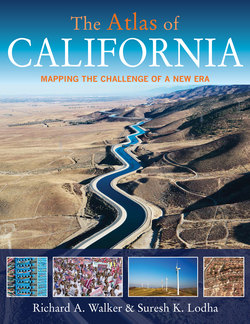Читать книгу The Atlas of California - Suresh K. Lodha - Страница 12
На сайте Литреса книга снята с продажи.
ОглавлениеCalifornia has created too few new jobs for too long, and it absolutely cratered in the Great Recession, with over 2 million workers unemployed and some of the highest unemployment rates in the country, whether measured by state, county, or metropolitan area. This was the vortex of the housing bubble, with more price inflation and bad loans than any other state, ending with a crash that left more lost value, house foreclosures and underwater mortgages than anywhere in the world, as we note in Chapter 4. Recovery has been slow and painful, even five years after the crash. The problems run even deeper than recession indicators or government budget deficits, however. While California has a long history as a financial center and a place of periodic financial shenanigans, as discussed in Chapter 3, it has been Wall Street West when it comes to the present age of greed, going back to Michael Milken’s dodgy Junk Bond empire run out of LA and the Savings and Loan debacle of the 1980s. In the 2000s, California banks such as Countrywide Savings and Golden West Savings were the worst offenders in issuing subprime, adjustable rate, and jumbo mortgages, setting up homeowners for the fall. And the reason there were so many people ready to take the bait was that house prices had bloated up out of reach of ordinary household incomes, which had been stagnant for years among the lower half of wage earners, as noted in Chapter 4. Even more disturbing in light of California’s history of relative equality and a wide middle class, the state has recently been in the vanguard when it comes to widening inequality. On the one hand, wages and salaries have gone nowhere fast, and poverty rates have shot up with every recession, as remarked upon in Chapters 3 and 8. On the other hand, people at the top have done all too well. The top 10 to 20 percent of professional, technical, and managerial workers have ridden their skills and position to happy heights on the tsunami of high-tech profits. Even worse has been the untrammeled enrichment of the top 1 percent—even 0.1 percent—of wealth holders. California has more billionaires and millionaires than any other state, led by tech heroes, movie moguls and investment bankers. Companies like Apple, Chevron, and Wells Fargo are awash in money. At the same time, inequality has grown to the worst levels in US history, California has become the most racially diverse state in the country, in which the vast majority of working people are people of color, and Whites have become a minority. California is one of the great experiments of our time in the potential for a racially blended society, the hope—never realized—of the Great American Melting Pot and the possibility of a non-White working class joining the ranks of that other idolized entity, the Great American Middle Class. There are certainly hopeful signs, such as the rising percentage of mixed-race children in the state and the surging numbers of young college students of color on the campuses of the state colleges and universities. But the obstacles to full admission to the California Dream are considerable. Today’s youth are being hit from all directions: by more poverty, greater hunger, worse schools, and grimmer job prospects, as seen in Chapters 7 and 8. Meanwhile, some of California’s greatest material accomplishments of the past have gone sour and left serious problems for today’s citizens. The wastelands and toxicity of the mining era are still with us, especially in the Sacramento Valley. Clear cutting of timber and the roads built into the Klamath and Siskiyou mountains have left the North Coast with a legacy of silted and clogged rivers. The industrial farming practiced by California agribusiness has left its mark, with pesticides and nitrates in groundwater, toxic runoff, and saline soils throughout the Central Valley. We detail these problems in Chapter 6, which looks more closely at air and water pollution. There, too, we take up the most salient output of modern California, carbon emissions, and the chilling prospects of climate change. To their credit, Californians have often been the first to see the damage of unrestricted industrialization and urbanization, and to call for preservation and restoration of the natural landscape. No place has been more aggressive in taking up the cudgels in defense of the
13
